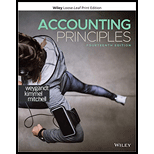
(a)
Perpetual Inventory System
Perpetual Inventory System refers to the inventory system that maintains the detailed records of every inventory transactions related to purchases and sales on a continuous basis. It shows the exact on-hand-inventory at any point of time.
Periodic Inventory System: It is a system in which the inventory is updated in the accounting records on a periodic basis such as at the end of each month, quarter or year. In other words, it is an accounting method which is used to determine the amount of inventory at the end of each accounting period.
Journalizing: Journal is the book of original entry whereby all the financial transactions are recorded in chronological order. Under this method each transaction has two sides, debit side and credit side. Total amount of debit side must be equal to the total amount of credit side. In addition, it is the primary books of accounts for any entity to record the daily transactions and processed further till the presentation of the financial statements.
Accounting rules for
- To Increase balance of the account: Debit assets, expenses, losses and credit all liabilities, capital, revenue and gains.
- To Decrease balance of the account: Credit assets, expenses, losses and debit all liabilities, capital, revenue and gains.
To Prepare: Journal entries and adjusting entries (perpetual inventory system)
(b)
T-Account: T-Account is a form of ledger account in which the debit entries are shown at the left side of the account and credit entries are shown at the right side of the account.
To Prepare: T-Accounts
(c)
Adjusted
To Prepare: Adjusted Trial Balance
(d)
Income Statement: The income statement is that financial statement which shows the net income (or loss) of the Company. In the income statement, to calculate the net income, all expenses incurred by the Company are deducted from the total revenue of the Company.
Classified
To Prepare: Income statement and classified balance sheet
(e)
To Prepare: ending inventory and cost of goods sold under FIFO (periodic inventory system)
(f)
To Prepare: ending inventory and cost of goods sold under LIFO (periodic inventory system).
Want to see the full answer?
Check out a sample textbook solution
Chapter 6 Solutions
ACCT.PRINCIPLES (LL)-PACKAGE
- Please provide the correct answer to this general accounting problem using accurate calculations.arrow_forwardUniversal Computing Solutions (UCS) sells laptops for $1,800 each and also provides a 2-year warranty, which requires the company to perform periodic services and replace defective parts. During 2024, the company sold 750 laptops. Based on past experience, the company has estimated the total 2-year warranty costs per laptop as $45 for parts and $75 for labor. (Assume sales all occur on December 31, 2024.) In 2025, UCS incurred actual warranty costs relative to 2024 laptop sales of $12,000 for parts and $25,000 for labor. Under the expense warranty treatment (accrual method), what is the balance under current liabilities in the 2024 balance sheet? a. $90,000 b. $120,000 c. $100,000 d. $85,000arrow_forwardI need help finding the accurate solution to this general accounting problem with valid methods.arrow_forward

 AccountingAccountingISBN:9781337272094Author:WARREN, Carl S., Reeve, James M., Duchac, Jonathan E.Publisher:Cengage Learning,
AccountingAccountingISBN:9781337272094Author:WARREN, Carl S., Reeve, James M., Duchac, Jonathan E.Publisher:Cengage Learning, Accounting Information SystemsAccountingISBN:9781337619202Author:Hall, James A.Publisher:Cengage Learning,
Accounting Information SystemsAccountingISBN:9781337619202Author:Hall, James A.Publisher:Cengage Learning, Horngren's Cost Accounting: A Managerial Emphasis...AccountingISBN:9780134475585Author:Srikant M. Datar, Madhav V. RajanPublisher:PEARSON
Horngren's Cost Accounting: A Managerial Emphasis...AccountingISBN:9780134475585Author:Srikant M. Datar, Madhav V. RajanPublisher:PEARSON Intermediate AccountingAccountingISBN:9781259722660Author:J. David Spiceland, Mark W. Nelson, Wayne M ThomasPublisher:McGraw-Hill Education
Intermediate AccountingAccountingISBN:9781259722660Author:J. David Spiceland, Mark W. Nelson, Wayne M ThomasPublisher:McGraw-Hill Education Financial and Managerial AccountingAccountingISBN:9781259726705Author:John J Wild, Ken W. Shaw, Barbara Chiappetta Fundamental Accounting PrinciplesPublisher:McGraw-Hill Education
Financial and Managerial AccountingAccountingISBN:9781259726705Author:John J Wild, Ken W. Shaw, Barbara Chiappetta Fundamental Accounting PrinciplesPublisher:McGraw-Hill Education





